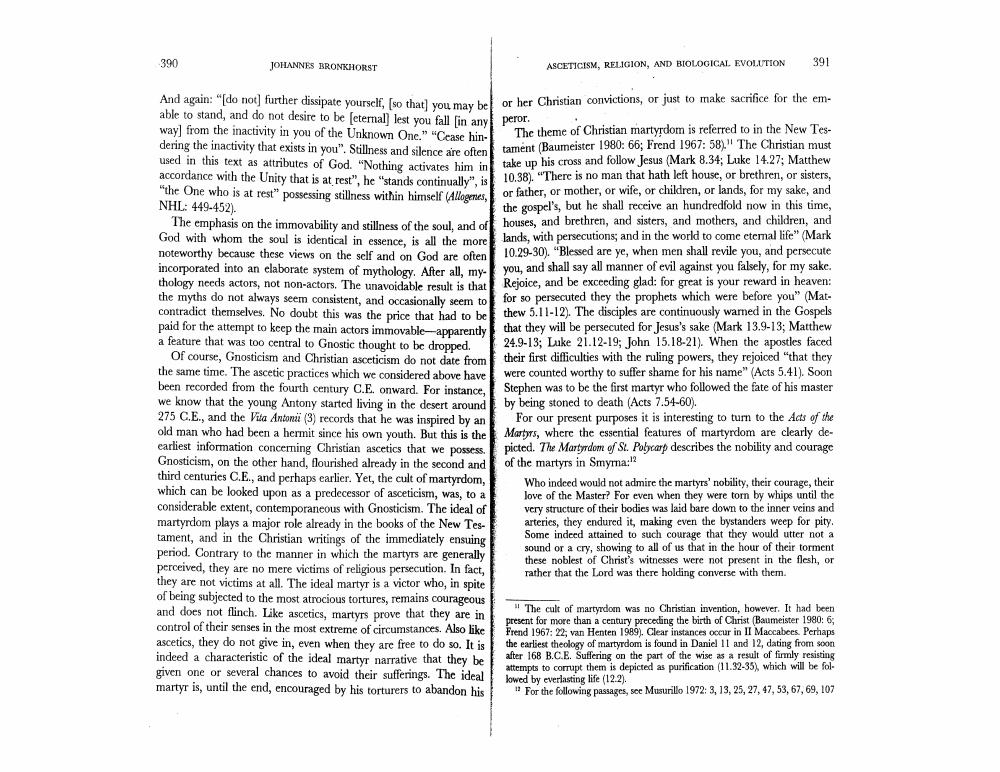Book Title: Asceticism Religion And Biological Evolution Author(s): Johannes Bronkhorst Publisher: Johannes Bronkhorst View full book textPage 9
________________ 390 JOHANNES BRONKHORST And again: "[do not] further dissipate yourself, [so that] you may be able to stand, and do not desire to be [eternal] lest you fall [in any way] from the inactivity in you of the Unknown One." "Cease hindering the inactivity that exists in you". Stillness and silence are often used in this text as attributes of God. "Nothing activates him in accordance with the Unity that is at rest", he "stands continually", is "the One who is at rest" possessing stillness within himself (Allogenes, NHL: 449-452). The emphasis on the immovability and stillness of the soul, and of God with whom the soul is identical in essence, is all the more noteworthy because these views on the self and on God are often incorporated into an elaborate system of mythology. After all, mythology needs actors, not non-actors. The unavoidable result is that the myths do not always seem consistent, and occasionally seem to contradict themselves. No doubt this was the price that had to be paid for the attempt to keep the main actors immovable-apparently a feature that was too central to Gnostic thought to be dropped. Of course, Gnosticism and Christian asceticism do not date from the same time. The ascetic practices which we considered above have been recorded from the fourth century C.E. onward. For instance, we know that the young Antony started living in the desert around 275 C.E., and the Vita Antonii (3) records that he was inspired by an old man who had been a hermit since his own youth. But this is the earliest information concerning Christian ascetics that we possess. Gnosticism, on the other hand, flourished already in the second and third centuries C.E., and perhaps earlier. Yet, the cult of martyrdom, which can be looked upon as a predecessor of asceticism, was, to a considerable extent, contemporaneous with Gnosticism. The ideal of martyrdom plays a major role already in the books of the New Testament, and in the Christian writings of the immediately ensuing period. Contrary to the manner in which the martyrs are generally perceived, they are no mere victims of religious persecution. In fact, they are not victims at all. The ideal martyr is a victor who, in spite of being subjected to the most atrocious tortures, remains courageous and does not flinch. Like ascetics, martyrs prove that they are in control of their senses in the most extreme of circumstances. Also like ascetics, they do not give in, even when they are free to do so. It is indeed a characteristic of the ideal martyr narrative that they be given one or several chances to avoid their sufferings. The ideal martyr is, until the end, encouraged by his torturers to abandon his ASCETICISM, RELIGION, AND BIOLOGICAL EVOLUTION 391 or her Christian convictions, or just to make sacrifice for the emperor. The theme of Christian martyrdom is referred to in the New Testament (Baumeister 1980: 66; Frend 1967: 58)," The Christian must take up his cross and follow Jesus (Mark 8.34; Luke 14.27; Matthew 10.38). "There is no man that hath left house, or brethren, or sisters, or father, or mother, or wife, or children, or lands, for my sake, and the gospel's, but he shall receive an hundredfold now in this time, houses, and brethren, and sisters, and mothers, and children, and lands, with persecutions; and in the world to come eternal life" (Mark 10.29-30). "Blessed are ye, when men shall revile you, and persecute you, and shall say all manner of evil against you falsely, for my sake. Rejoice, and be exceeding glad: for great is your reward in heaven: for so persecuted they the prophets which were before you" (Matthew 5.11-12). The disciples are continuously warned in the Gospels that they will be persecuted for Jesus's sake (Mark 13.9-13; Matthew 24.9-13; Luke 21.12-19; John 15.18-21). When the apostles faced their first difficulties with the ruling powers, they rejoiced "that they were counted worthy to suffer shame for his name" (Acts 5.41). Soon Stephen was to be the first martyr who followed the fate of his master by being stoned to death (Acts 7.54-60). For our present purposes it is interesting to turn to the Acts of the Martyrs, where the essential features of martyrdom are clearly depicted. The Martyrdom of St. Polycarp describes the nobility and courage of the martyrs in Smyma:12 Who indeed would not admire the martyrs' nobility, their courage, their love of the Master? For even when they were torn by whips until the very structure of their bodies was laid bare down to the inner veins and arteries, they endured it, making even the bystanders weep for pity. Some indeed attained to such courage that they would utter not a sound or a cry, showing to all of us that in the hour of their torment these noblest of Christ's witnesses were not present in the flesh, or rather that the Lord was there holding converse with them. "The cult of martyrdom was no Christian invention, however. It had been present for more than a century preceding the birth of Christ (Baumeister 1980: 6; Frend 1967: 22; van Henten 1989). Clear instances occur in II Maccabees. Perhaps the earliest theology of martyrdom is found in Daniel 11 and 12, dating from soon after 168 B.C.E. Suffering on the part of the wise as a result of firmly resisting attempts to corrupt them is depicted as purification (11.32-35), which will be followed by everlasting life (12.2). "For the following passages, see Musurillo 1972: 3, 13, 25, 27, 47, 53, 67, 69, 107Page Navigation
1 ... 7 8 9 10 11 12 13 14 15 16 17 18 19 20 21 22 23
